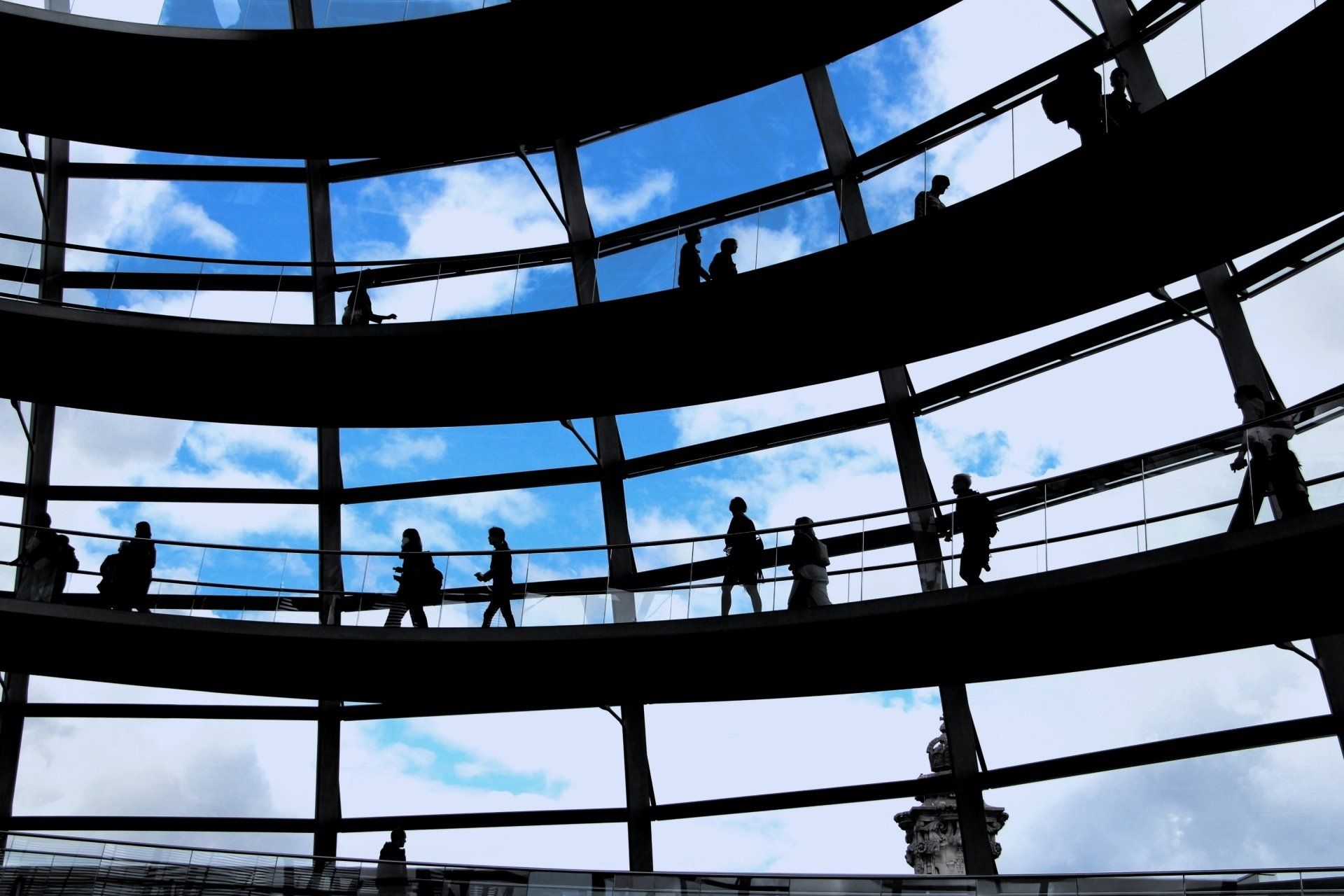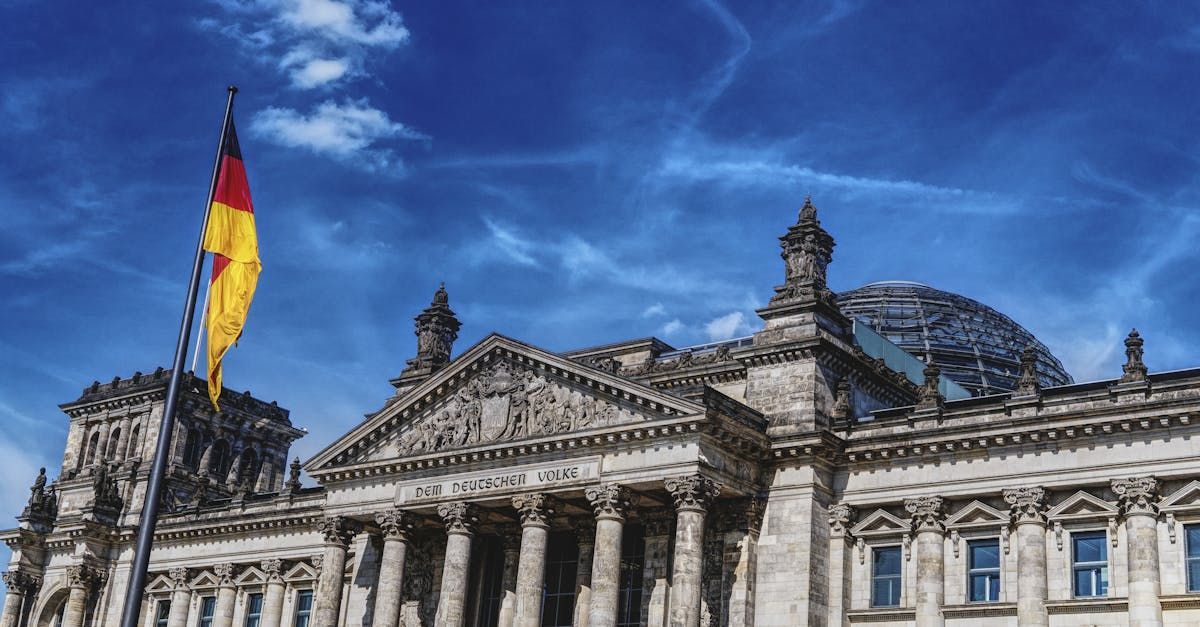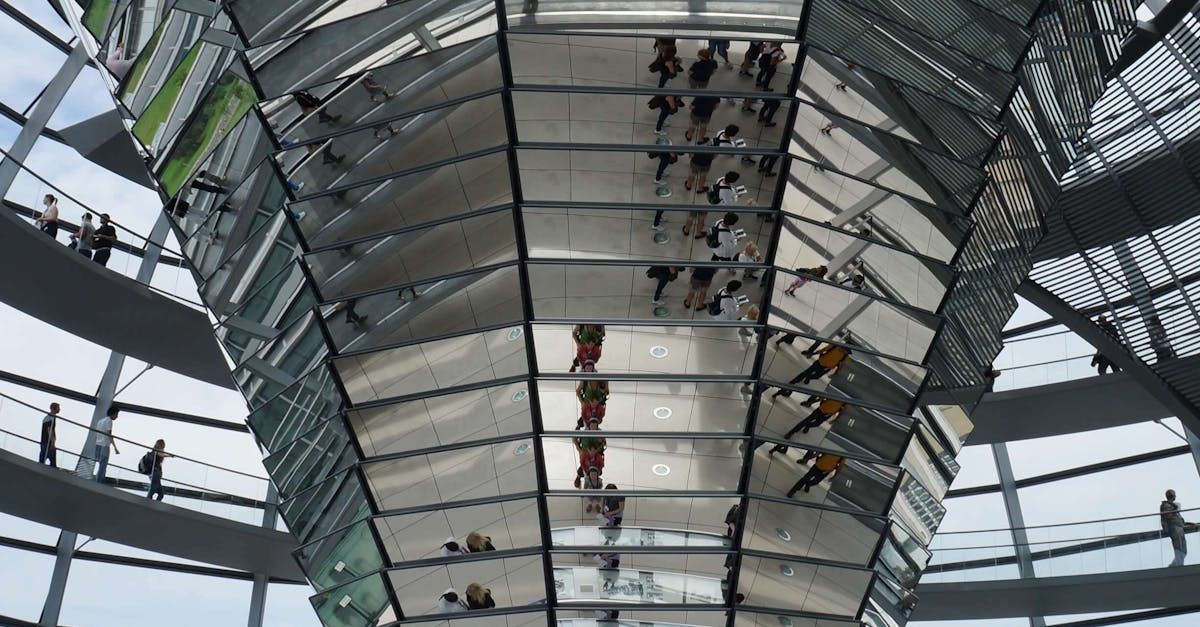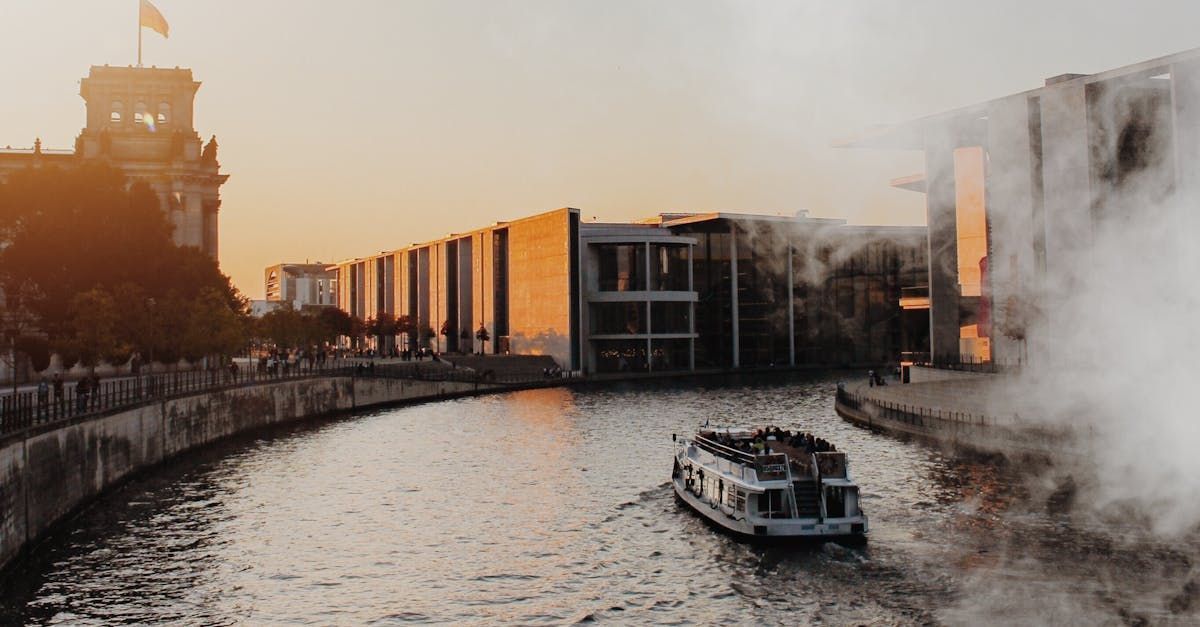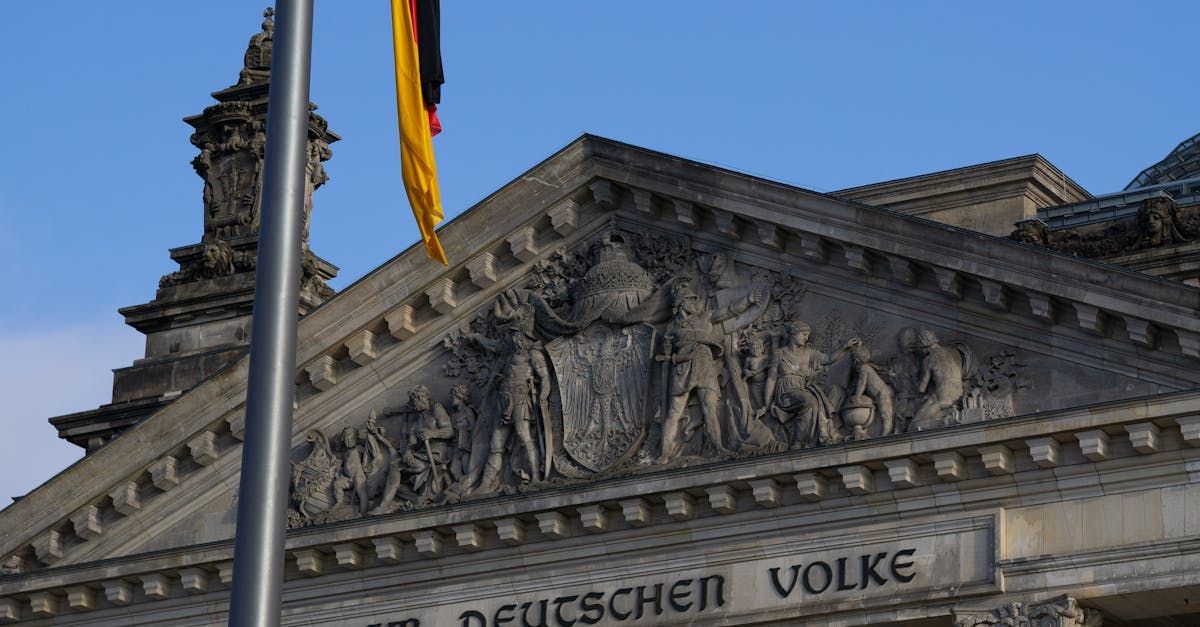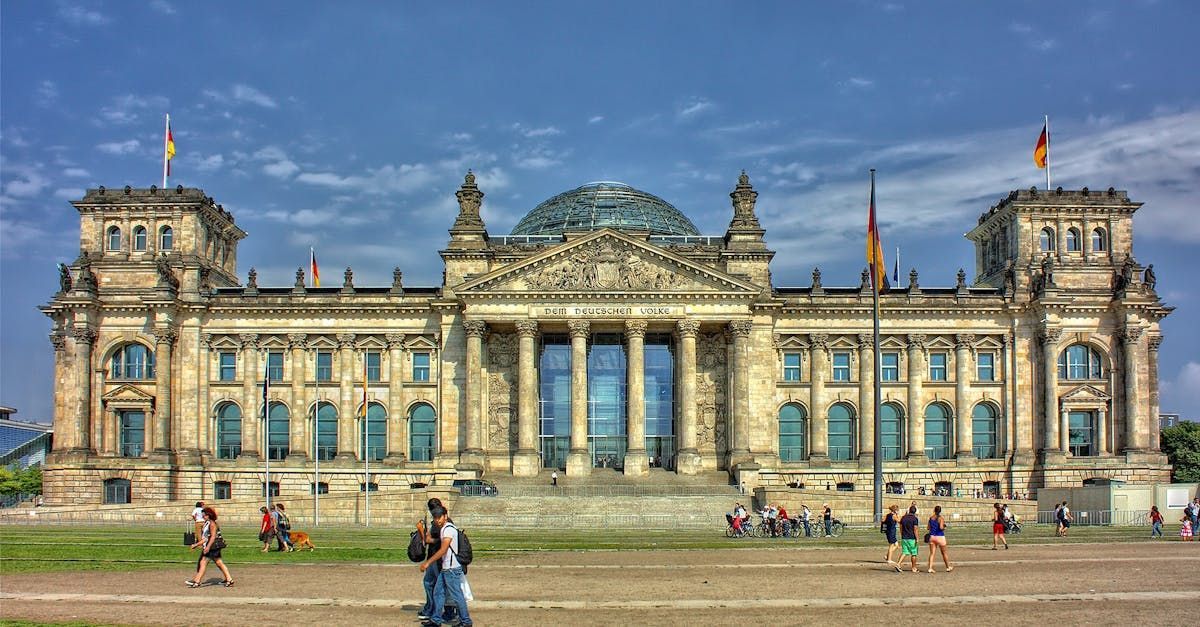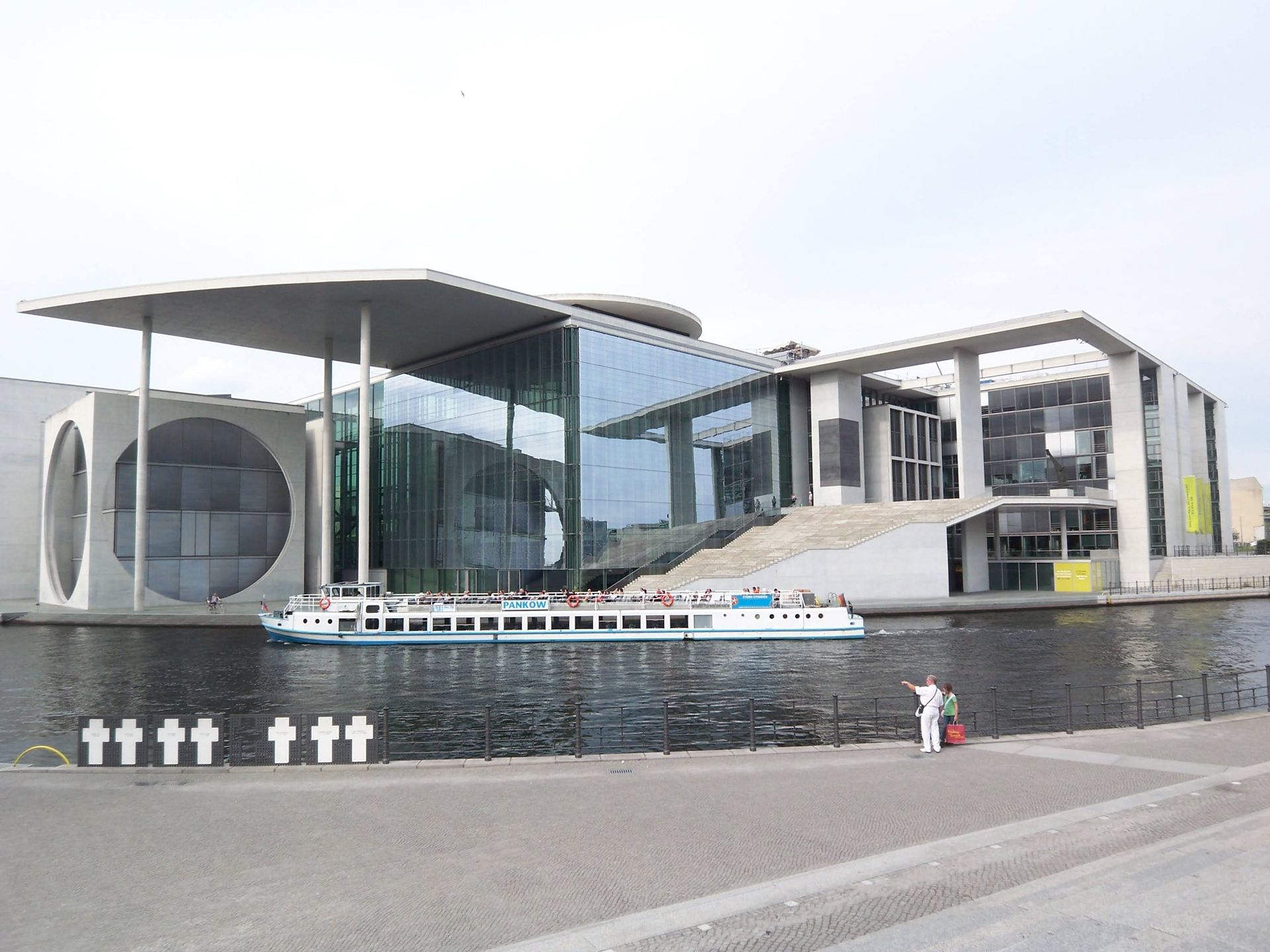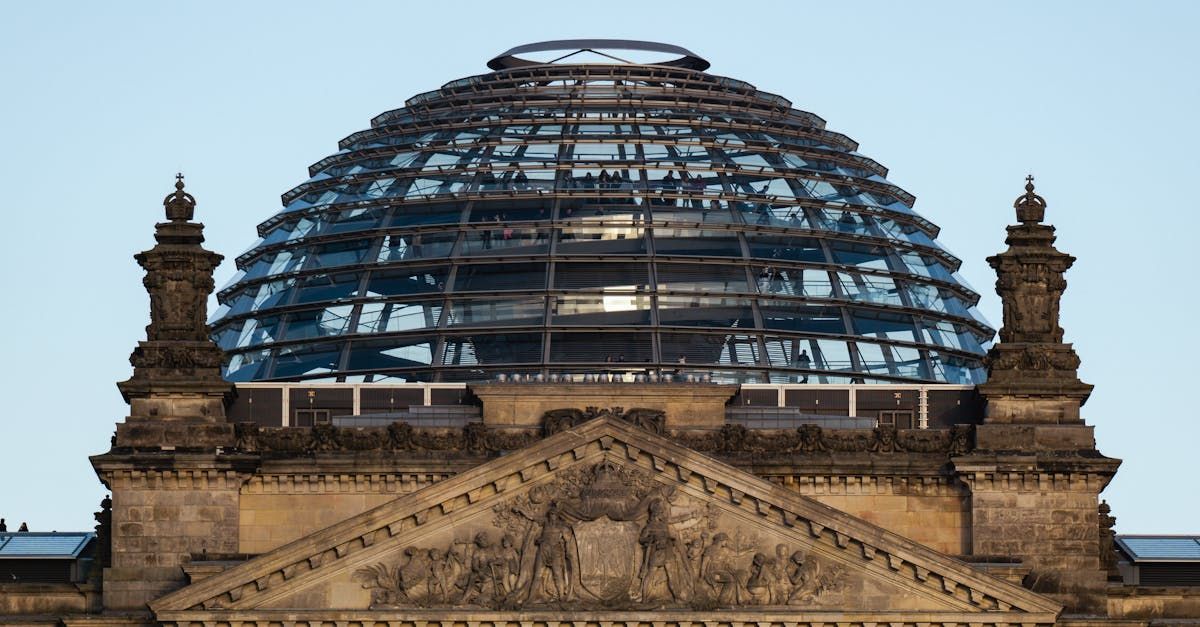Guided Reichstag Tour in Berlin
A great insider tip for your visit to Berlin is booking a guided tour of the Reichstag building offered by the Bundestag. The tours are free, but must be booked in advance.
When you visit Berlin, you should definitely explore the Reichstag building. A visit to the Reichstag offers a unique glimpse into the heart of German democracy. It's not just a political symbol, but also an architectural gem with a fascinating history. The guided tours provide an insightful experience, showcasing the building's rich history, stunning architecture, and the importance of its role in modern politics. Exploring the glass dome allows visitors to enjoy breathtaking views of Berlin while learning about key historical events that shaped the nation.
As you navigate through the halls of this iconic structure, the blend of historical significance and contemporary design becomes evident. Whether you are a history buff or simply curious about Germany's political landscape, the Reichstag is a must-see destination that provides valuable context to the country's governance and heritage.
Personally, we try to take all our visitors on one of these free tours. Although we have participated in the Reichstag tour four times, the Reichstag building is so large and diverse that we discover a new area with each visit.
Highlights of the Free Reichstag Tour offered by the Bundestag
- The guides are experienced and motivated, and the tours are informative, interesting, and exciting.
- Architecture and Art: Admire the impressive architecture of the Reichstag, which is a mix of historical and modern elements. In the Reichstag, you can also find various artworks, such as the "Archive of German Deputies" by French artist Christian Boltanski, which consists of almost 5000 metal boxes.
- Soldier Graffiti: During World War II, Soviet soldiers left their marks on the walls of the Reichstag. This graffiti is a moving testimony of the past and is shown on the tour.
- Plenary Hall and Political Processes: During the tour, you will visit the plenary hall, where important political debates take place. Here you will learn more about the German political system and the role of the Reichstag.
- The Dome: The glass dome is the highlight and conclusion of the tour. The glass dome, designed by Sir Norman Foster, is a masterpiece of engineering and offers a breathtaking view over Berlin. You can walk up the ramp of the dome while listening to an audio guide.
Practical Tips for visiting the Reichstag
- Book in advance: The tours are popular and often fully booked. Reserve your spot online in time to avoid disappointment: Bundestag tour reservation
- Language: Most tours are offered in German or English. Choose the language that suits you best.
- Duration: The tour lasts about 1.5 hours. Plan enough time to explore all aspects of the Reichstag.
- Arrive on time: Security clearance takes time and there are often queues in front of the Reichstag, so plan enough time to avoid being late.
- Take some time after visiting the Reichstag to explore the surroundings. Don't miss:
- the "White Crosses" memorial site on the banks of the Spree
- the Library of the German Bundestag
- the Tiergarten
- Brandenburg Gate
- Memorial to the Murdered Jews
Free Alternatives offered by the Bundestag
The Bundestag also offers two other options under the above link:
- A Lecture held in the visitors’ gallery overlooking the plenary chamber followed by a visit to the dome. We haven't tried this tour ourseves, but since you get to visit the visitors’ gallery during the guided tour anyway, the latter one seems like the better option.
- Visit to the dome
The last option, only visiting the dome, as a lot more availability than the prior too. It's still a worthwhile option, since the dome is a fascinating piece of architecture with a breathtaking view. Plus there is also a free audio guide available at the entrance to the dome.
Paid Alternatives
If the free tours via the Bundestag website are fully booked, there are also highly rated paid alternatives:
Berlin: Plenary Chamber, Dome & Government District Tour*
Berlin: Government Quarter Tour and Reichstag Dome Visit*
*Affiliate Links
Further reading
History of the Reichstag
The Reichstag has a rich and complex history, spanning from its construction in the late 19th century through significant political changes and challenges. This section outlines key developments, including its inception, its role during the Weimar Republic, the damage it sustained, and its enduring historical significance.
Construction and Inauguration
Designed by architect Paul Wallot, the Reichstag Building's construction began in 1884 and was completed in 1894. The building features Neo-Renaissance architectural style, characterized by its grand facade and impressive dome.
The inauguration took place on December 9, 1894, showcasing the building's role as the seat of the Imperial Diet of the German Empire.
Its location in Berlin was strategically chosen, symbolizing the political heart of Germany. The inscription "Dem Deutschen Volke" (To the German People) was added to the facade in 1916, further solidifying its significance.
Weimar Republic Era
The Weimar Republic (1919-1933) marked a turbulent period for the Reichstag. Functioning as Germany's parliament during this time, it became a focal point for political struggles.
The building hosted numerous noteworthy debates and sessions, but it was also a site of intense conflict.
The Reichstag Fire on February 27, 1933, drastically shifted its role in German politics. This event, blamed on a young Dutch communist, allowed the Nazi regime to exploit fears and consolidate power through the Reichstag Fire Decree.
Damage and Reconstruction
The Reichstag suffered significant damage following the fire in 1933, leading to its abandonment for several years.
During World War II, the building was further damaged by bombing raids, resulting in its near destruction.
After the war, the divided city of Berlin left the Reichstag in a dilapidated state. It wasn't until the reunification of Germany in 1990 that plans for extensive reconstruction were set in motion. British architect Norman Foster led the renovation, transforming the building into a modern parliamentary facility while preserving its historical elements.
Historical Significance
The Reichstag's importance extends beyond its architecture and function. It symbolizes Germany's tumultuous political history and its journey toward democracy.
As the site of crucial legislative actions, it represented both the aspirations and failures of various German governments over the decades.
Today, it stands as a testament to resilience and a reminder of the past, playing a vital role in Germany's democratic processes and serving as a popular tourist attraction, drawing millions each year. Its glass dome is particularly symbolic of transparency in governance, allowing visitors to connect with the political workings of modern Germany.
Architecture and Design
The Reichstag Building is an iconic representation of German architecture, blending historical elements with modern innovations. Its design reflects the turbulent history of Germany while highlighting sustainability and functionality.
Exterior Features
The exterior of the Reichstag showcases a blend of neo-Renaissance and modernist styles. The façade is characterized by its grand entrance, adorned with columns and a massive inscription that reads “Dem Deutschen Volke” (To the German People).
The distinctive glass roof and the large dome are focal points that contrast beautifully with the historic stone structure. The use of local materials pays homage to German craftsmanship. Alongside the ornate detailing, the exterior incorporates large windows that not only enhance aesthetic appeal but also allow natural light to flood the interior spaces.
Interior Layout
Inside, the Reichstag features a functional layout that accommodates its role as the seat of the German Parliament. The main parliamentary chamber is circular, symbolizing openness and democracy.
This layout allows for effective communication among members, fostering transparency in political discourse. The surrounding areas include meeting rooms, offices, and public galleries, each designed with accessibility in mind. The color palette and materials were chosen to create a welcoming atmosphere, reflecting modern German values while respecting historical significance.
The Glass Dome
One of the most iconic features of the Reichstag is its glass dome, designed by architect Sir Norman Foster. The dome serves as a symbolic representation of transparency in government.
Visitors can walk up a spiral ramp to reach the top, providing panoramic views of Berlin. The dome is also functional; it allows natural light into the chamber below and acts as a ventilation system, promoting energy efficiency. Its reflective design ensures that the chamber remains illuminated even on darker days, enhancing the overall work environment.
Sustainability Measures
Sustainability is a key aspect of the Reichstag's design. The building incorporates innovative energy-saving technologies, such as a rainwater recycling system for irrigation and restroom use.
Solar panels installed on the roof help provide renewable energy, reducing reliance on traditional power sources. Additionally, the glass dome's design optimizes daylight usage, lessening the need for artificial lighting. These measures reflect Germany's commitment to sustainability and create a model for environmentally friendly public buildings.
Visiting the Reichstag
Visiting the Reichstag offers a unique opportunity to explore a pivotal part of German history and contemporary politics. This iconic building combines impressive architecture with a rich narrative that reflects the evolution of Germany's democracy.
Opening Hours
The Reichstag is open to the public daily from 8:00 AM to Midnight. It's important to note that the last entry to the dome is at 10:00 PM. While the building welcomes visitors all year round, it closes entirely on December 24th and operates on a reduced schedule on New Year's Eve. It’s advisable to check for any special closures or events that might affect accessibility.
Ticketing and Reservations
To visit the dome and roof terrace, pre-registration is mandatory. This can be done through an online booking form. Visits can be made free of charge, but an advance reservation is crucial to secure your spot. If last-minute changes arise, spontaneous registrations are occasionally available on-site. Check the official website for real-time information on entry requirements and reservation procedures.
Guided Tour Options
Guided tours provide deeper insights into the Reichstag's architecture, history, and function. Tours cater to various audiences, including families and individuals. Regular tours run several times a day, including options specifically designed for families with children aged six to fourteen. These tours focus on the history and significance of Parliament, making them both educational and engaging.
Accessibility Information
The Reichstag is committed to accessibility for all visitors. The building features ramps and elevators to accommodate individuals with mobility impairments. Guided tours can also be tailored for visitors requiring additional assistance. Moreover, audio guides and multilingual information panels are available, ensuring that everyone can enjoy the rich history of this landmark.
For the most current accessibility options, checking the official website prior to your visit is recommended.
Security and Regulations
Visiting the Reichstag requires adherence to specific security measures and regulations to ensure a safe experience for all guests. Understanding these protocols is essential before your visit.
Entrance Security Checks
All visitors must undergo security checks at the entrance to the Reichstag. Expect to present a valid identification document, such as a passport or national ID card. Personal bags and belongings will also be screened using metal detectors.
Allow sufficient time for these checks, as queues can vary. Security staff may conduct additional searches if deemed necessary. It is advisable to arrive at least 30 minutes before your scheduled tour time to accommodate these procedures.
Prohibited Items
Certain items are strictly prohibited inside the Reichstag to maintain safety and security. These include, but are not limited to:
- Weapons: Firearms, knives, and any item considered a weapon are not allowed.
- Large bags: Visitors should leave large backpacks or suitcases at home.
- Sharp objects: Items such as scissors or tools that can cause injury are banned.
- Flammable materials: This includes lighters and any explosive substances.
Review the full list of prohibited items on the official website prior to your visit to avoid any inconvenience.
Visitor Conduct
Visitors are expected to maintain respectful conduct during their time at the Reichstag. This includes refraining from any disruptive behavior, such as loud talking or inappropriate comments.
Photography is generally allowed but should be limited to non-sensitive areas. Additionally, it is important to follow the guidance of tour leaders and security personnel at all times.
Any person observed violating conduct regulations may be asked to leave the premises. Adhering to these guidelines ensures a pleasant atmosphere for everyone involved.
Events and Exhibitions
The Reichstag building hosts a variety of events and exhibitions that enrich the visitor experience. These activities reveal the historical significance of the building and its role in modern governance. The following subsections provide a closer look at permanent exhibits, temporary exhibitions, plenary sessions, and special events held at the Reichstag.
Permanent Exhibits
The Reichstag features several permanent exhibits designed to educate visitors about German history and democracy. One notable exhibit is "The Democratic Experience," which showcases the development of democracy in Germany, emphasizing key historical moments and figures.
Visitors can explore interactive displays and multimedia presentations that delve into the workings of the German Bundestag. This engaging environment allows guests to examine the principles of democracy and the structure of the parliamentary system.
Temporary Exhibitions
In addition to its permanent displays, the Reichstag hosts temporary exhibitions that change regularly, offering fresh perspectives on various themes. These exhibitions often focus on contemporary issues, historical anniversaries, or artistic interpretations related to politics and society.
For example, recent exhibitions have highlighted significant events in Germany’s past, such as reunification or the 75th anniversary of the Bundestag. These exhibits typically feature works from renowned artists and historians, providing a multifaceted look at Germany's evolving landscape.
Plenary Sessions
Plenary sessions at the Reichstag are a core component of parliamentary life. These sessions allow Members of Parliament (MPs) to gather, debate legislation, and discuss national matters. Visitors can observe these sessions, which take place regularly, offering an authentic view of political processes in action.
Guided tours often include attendance at a plenary session, leading to a deeper understanding of parliamentary procedures. Observing debates in person gives visitors insights into the challenges and responsibilities faced by elected officials.
Special Events
The Reichstag building also hosts various special events throughout the year, including public talks, lectures, and educational workshops. These events cater to a diverse audience, ranging from students to professionals interested in political science and public affairs.
Prominent speakers, including politicians, scholars, and activists, often participate in these events, encouraging dialogue on pressing issues. Visitors can check the official website for upcoming events and ensure they don’t miss the opportunity to engage with experts in the field.
Dining and Souvenirs
Visitors to the Reichstag can enjoy unique dining options and find memorable souvenirs that reflect their experience. The on-site restaurant offers a blend of culinary excellence, while gift shops provide a variety of keepsakes.
On-Site Restaurants
The Käfer Restaurant, located on the rooftop of the Reichstag, is a must-visit for diners. It features modern German cuisine and offers stunning views of Berlin from its terrace. Reservations are recommended, and guests can enjoy a range of dishes made with regional ingredients.
Additionally, the restaurant typically provides a seasonal menu, enhancing the dining experience. Visitors can indulge in delicious meals while taking in the historical ambiance surrounding them. A highlight is the four-course dinner option, which also includes an aperitif and selections for coffee or tea, making it a perfect choice for a memorable evening.
Gift Shops
The gift shops at the Reichstag offer a diverse selection of souvenirs. Items range from books about the building's history to unique gifts that capture the spirit of Berlin. Visitors can find postcards, keychains, and locally made products that serve as perfect mementos.
For those interested in educational materials, the shops include informative publications on German politics and the parliamentary system. These souvenirs not only remind visitors of their trip but also offer insight into the significance of the Reichstag in Germany's democratic history.
Nearby Attractions
When visiting the Reichstag, several significant attractions are within walking distance. These sites offer a deeper understanding of Berlin's history and culture, enhancing your overall experience in the city.
Brandenburg Gate
The Brandenburg Gate is a landmark symbol of Berlin, located just a short walk from the Reichstag. This neoclassical monument has stood since the 18th century and represents peace and unity.
Visitors can admire its impressive architecture, featuring twelve Doric columns. The gate historically marked the entrance to the city and now serves as a popular meeting point. Tourists often take photos in front of this iconic structure.
Nearby, you’ll find the Pariser Platz with various shops and cafes, ideal for a quick bite or coffee break. The gate is not just a monument but also a vibrant area fostering cultural events.
Tiergarten Park
Adjacent to the Reichstag, Tiergarten Park is one of Berlin's largest urban parks, covering over 500 acres. Originally a hunting ground, it evolved into a public park featuring beautiful pathways, lakes, and open spaces.
Visitors can stroll along tree-lined avenues, visit the picturesque fountains, and relax on the grassy lawns. The park offers art installations and monuments, adding to its cultural significance.
You can also find cafes within the park for refreshments or engage in recreational activities like cycling or jogging. Tiergarten is a perfect place to unwind after exploring the historical sites nearby.
Memorial to the Murdered Jews of Europe
The Memorial to the Murdered Jews of Europe, commonly known as the Holocaust Memorial, lies a short distance from the Reichstag. This poignant site consists of 2,711 concrete slabs of varying heights, designed to evoke feelings of loss and disorientation.
Visitors walk through the maze-like structure, offering a reflective experience. The memorial serves as a tribute to the Jewish victims of the Holocaust, emphasizing the importance of remembrance.
Additionally, an underground information center provides educational resources and survivor testimonies. This site stands as a critical reminder of history and its lessons, making it a meaningful addition to any visit.
Photography and Filming
Photography and filming are allowed inside the Reichstag building, but there are specific guidelines to follow. Visitors should be respectful of others while capturing images.
Guidelines for Photography
- Areas Permitted: You can take photos in most areas, including the dome and surrounding views.
- Restrictions: Some sensitive areas may have restrictions or prohibitions on photography. Always look for signs indicating such rules.
Tips for Capturing Great Photos
- Timing: Early morning or late afternoon provides the best lighting for photography, enhancing the architectural beauty.
- Equipment: A smartphone or a camera with a good lens can help capture detailed shots of the dome and the assembly hall.
Respecting Others
- Consideration: Be mindful of other visitors to avoid obstructing their experiences.
- Flash Use: Avoid using flash as it can distract others and is often discouraged in guided tours.
By following these guidelines, you can enjoy capturing memorable shots of the Reichstag while being considerate of your surroundings.
Getting There
Reaching the Reichstag is straightforward with various transportation options available. Whether traveling via public transport or by car, visitors can conveniently access this significant landmark in Berlin.
Public Transportation
The Reichstag Building is well-served by Berlin's efficient public transportation system. The nearest subway station is Bundestag, located just a short walk away. Additionally, several bus lines, including M41 and 200, stop near the building.
For those using the S-Bahn, the Brandenburger Tor station is also within walking distance. It’s advisable to purchase a day pass for unlimited travel on all public transport. This pass allows visitors to navigate the city seamlessly while visiting other attractions.
Ensure to check the latest schedules and possible service adjustments on the BVG website.
Parking and Drop-Offs
Driving to the Reichstag can be efficient but may pose challenges regarding parking. Limited on-site parking is available for tourists, so planning ahead is essential. The closest parking garage is located at Reichstagsgebäude with limited spaces.
Alternatively, street parking around the area is subject to availability and usually requires payment. Those opting for a drop-off can use designated taxi stands near the entrance. It’s advisable to arrive early if using drop-off services, as traffic near popular attractions may be heavy, especially during peak tourist seasons.
For specific parking details and real-time information, consult local parking apps or websites.
Contact Information
For inquiries or assistance regarding tours of the Reichstag, you can reach out to their official visitor service. Here are the details:
- Phone: +49 30/227-32083
- Availability:
- Monday: 9:00 AM - 3:00 PM
- Tuesday to Thursday: 9:00 AM - 4:00 PM
- Friday: 9:00 AM - 1:30 PM
You can also find information about tours and registration on the official German Bundestag website.
For guided tour options, including family-friendly tours, check the listing at Guided Tours of the Reichstag.
If you need assistance immediately, visiting the Berlin tourism site offers additional resources for planning your visit.
Always verify the most current information about tours as there may be changes or specific requirements for entry.
Frequently Asked Questions
This section addresses common inquiries regarding the Reichstag tour, including ticket acquisition, registration processes, and specific details about the visitor experience. The following FAQs provide clarity on what to expect during your visit.
How can I obtain tickets for a Reichstag tour in English?
Tickets for a Reichstag tour in English can be obtained through the official Bundestag website. It's advisable to book in advance to secure your preferred date and time.
What is the process for online registration to visit the Bundestag?
To register online for a visit to the Bundestag, you need to fill out a form on the official Bundestag website. You'll need to provide personal information, such as your name, date of birth, and ID details.
Can I visit the Reichstag without booking in advance?
It is recommended to book in advance, as same-day tickets are limited. If you haven't booked, you may still be able to enter for the general viewing, but this is subject to availability.
What are the ticket prices for the Reichstag tour?
Entry to the Reichstag building is free. However, if you choose a guided tour, prices typically start at around €14. Check for guided options on the official site.
How much time does a tour of the Reichstag typically take?
A standard tour of the Reichstag usually lasts about 2 to 2.5 hours. This duration allows for a thorough exploration of key historical and architectural highlights.
What distinguishes the Reichstag from the Bundestag in terms of visitor experience?
The Reichstag refers specifically to the building housing the German parliament (Bundestag). Visitors enjoy guided tours focusing on the architectural history and political significance, while the Bundestag refers to the legislative activities conducted within the Reichstag.


